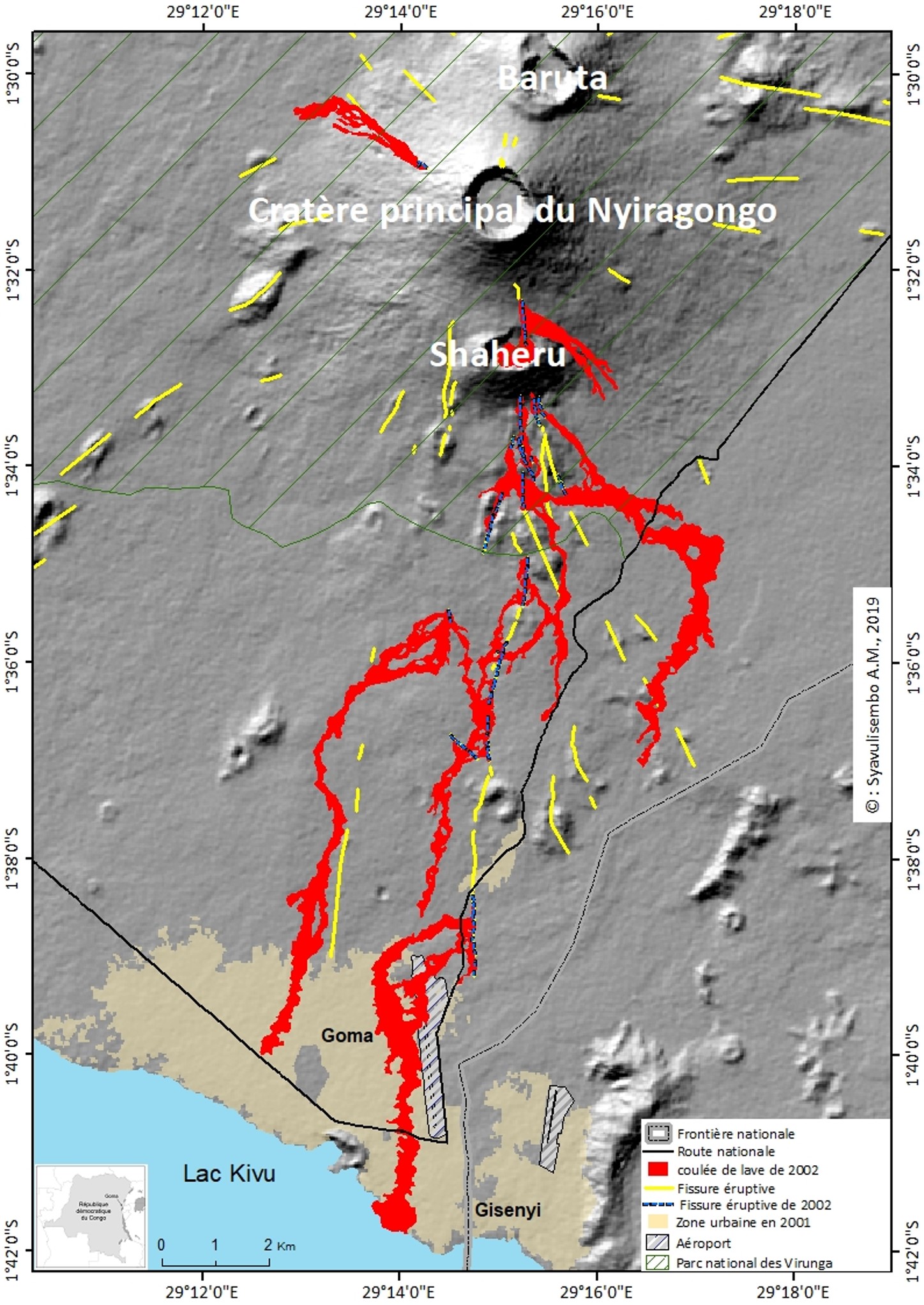De grote uitbarsting van de vulkaan Nyiragongo in 2002 (Goma, DR Congo)

17 januari 2002: Het was 21 jaar geleden... De vulkaan Nyiragongo is uitgebarsten en heeft een deel van de stad Goma (DR Congo) verwoest. Op deze nieuwspagina vindt u een video van getuigen van deze uitbarsting, aangevuld met een tekst die deze belangrijke gebeurtenis in de uitbarstingsgeschiedenis van de Nyiragongo beschrijft (uit Michellier, 2017).
"Ik was 20 in 2002": getuigenissen voor de jeugd van vandaag
Uit « Michellier, C. 2017. Contribuer à la prévention des risques d’origine géologique: l’évaluation de la vulnérabilité des populations dans un contexte de rareté de données. Les cas de Goma et Bukavu (RDCongo). Université Libre de Bruxelles/Vrije Universiteit Brussel ».
"Early in the morning of 17 January 2002, villagers witnessing abnormal activity north of the town of Goma did not have time to give the alert before the lava began to flow down from the flanks of Nyiragongo. In the early afternoon, the fracture system opened up south of the village of Munigi and the area was rapidly invaded by the very fluid lava flows which headed towards Goma and its airport (Komorowski et al. 2003). A new fissure appeared in the middle of the afternoon, more towards the west, representing also a real threat for the city of Goma. In total, millions of m³ of lava flowed, relatively slowly, into the city in two main branches (Allard et al., 2002; Baxter and Ancia, 2002; Komorowski et al., 2003). Via the eastern branch, a significant volume of lava reaches Lake Kivu at about 8.30 pm and flows into it at the level of the Les Volcans district, creating an overflow into the lake (Komorowski et al. 2003). Lava emissions stopped on the morning of 18 January, except at the Munigi fracture where activity was observed until the morning of 19 January (Komorowski et al. 2003). [...]
The lava flows destroyed roads, villages, and parts of the city's densest neighbourhoods (Murara, Virunga, Majengo), as well as the historic district of Les Volcans, leaving thousands homeless. In more detail, reports published after the disaster mention that the houses of about 120,000 people, or 17,500 households (Komorowski et al. 2003; Büscher 2011), were destroyed, as well as many community infrastructures (Virunga central market, 45 schools, 3 hospitals, 27 clinics, several administrative buildings) (ISIG-Goma 2003; Komorowski et al. 2003). About 10% of the urban area was devastated. The disaster also affected the local and regional economy by destroying the entire commercial centre (about 80% of the economic infrastructure) and one third of the airport runway (ISIG-Goma 2003). It also interrupted the electricity supply to about 21% of the official customers of the Société Nationale d'Électricité (SNEL) (Baxter and Ancia, 2002; Komorowski et al., 2003). [...]

Map of the 2002 Nyiragongo lava flows (from Muhindo Syavulisembo, 2019)
In 2002, from one day to the next, many people in Goma lost everything. Many saw the lava destroy their homes, savings and all their possessions in a few minutes. Yet, only a few years after the eruption, all the lava flows in the city of Goma were rebuilt (Büscher, 2011; Michellier et al., 2013). These new housing areas were gradually integrated into the urban landscape. In the report written by the Pole Institute in 2002, based on interviews with disaster victims, many stated that they knew that "the city will burn again, it happened in the past, it will happen in the future, but we are here and we will always be here" (Pole Institute 2002). Goma has remained an important local, regional and international pole of attraction, despite the enormous psychological impact of this past event and the threat of a new disaster (Büscher 2011)."
The eruption of May 2021 showed that the city indeed remains highly threatened by the unpredictable Nyiragongo volcano.
Smittarello, D. et al. Precursor-free eruption triggered by edifice rupture at Nyiragongo volcano. Nature (2022). https://doi.org/10.1038/s41586-022-05047-8
Under the volcano, Nature, Volume 609 Issue 7925, 1 September 2022
Bibliografie
- Allard, P, Baxter, P.J., Halbwachs, M., Komorowski, J.C.. 2002. The January 2002 eruption of Nyiragongo volcano (D.R. Congo) and related hazards: observations and recommendations. Final report of the French-British scientific team.
- Baxter, P.J., Ancia, A.. 2003. Human health and vulnerability in the Nyiragongo volcano eruption and humanitarian crisis at Goma, Democratic Republic of Congo. Acta Vulcanologica 14: 109–114.
- Büscher, K.. 2011. Conflict, state failure and urban transformation in the Eastern Congolese periphery: the case of Goma. PhD. Ghent University.
- ISIG-Goma. 2003. Etude globale sur la situation des ménages dans la ville de Goma après l’éruption du volcan Nyiragongo le 17 janvier 2002. Goma.
- Komorowski, J-C, Vaselli, O., Briole, P., Mavonga, G., Newhall, C.. 2003. The January 2002 flank eruption of Nyiragongo Volcano (Democratic Republic of Congo): chronology, evidence for a tectonic rift trigger, and impact of lava flows on the city of Goma. Acta Vulcanologica 15: 27–62.
- Michellier, C.. 2017. Contribuer à la prévention des risques d’origine géologique: l’évaluation de la vulnérabilité des populations dans un contexte de rareté de données. Les cas de Goma et Bukavu (RD Congo). PhD. Université Libre de Bruxelles/Vrije Universiteit Brussel.
- Michellier, C., Hanson, E., Kervyn, F., Wolff, E.. 2013. Le développement urbain de Goma/Rubavu: synonyme d’augmentation du risque aux aléas d’origine volcanique? AVCOR Conference 2017. Gisenyi, Rwanda.
- Muhindo Syavulisembo, A.. 2019. La variation spatio-temporelle de la population et l’analyse de l’accessibilité à ses ressources vitales: Vers une meilleure gestion du risque volcanique à Goma, République démocratique du Congo. PhD. Université Libre de Bruxelles.
- Pole Institute. 2002. Spécial Nyiragongo. 6. Regards Croisés. Goma.
